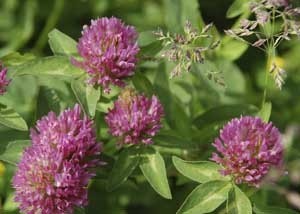
By the time the summer growing season ends, your garden soil has been depleted of many of the essential nutrients needed to sustain plant growth. Amending your soil with compost and manure is a great way to add those important nutrients back into your soil. Planting cover crops will not only add to your soil's fertility, but it will lock those nutrients into your soil and prevent them from washing away with spring rains.
Cover crops fall into two main categories: legumes and non-legumes. Within these groups are cold and warm season species that will work for every garden in every growing zone. Like the peas and beans you grow in the garden, legume cover crops convert nitrogen from the air and deposit it back into your soil. Examples of cover crops that are legumes include clovers, hairy vetch, and alfalfa.
Non-legume cover crops do not add nitrogen to the soil, but they provide more top growth, contributing more organic matter overall. They are also less susceptible to viruses and less apt to give soil-borne diseases safe harbor over winter. Examples of non-legume cover crops include annual ryegrass, barley, oats and winter rye. To give your garden the nitrogen boost crops need, while building up your soil's organic matter, try to mix one legume cover crop with one or more non-legume cover crop for the best benefits of both worlds.
Early fall is the optimal time to plant cover crops-after your garden is finished producing. September through mid October is a good time for zones 3 to 7, and October to Mid-November are good months for zones 8 to 10.
A local feed or farm supply store will be able to supply you with inexpensive, good quality seed. They will also carry the varieties best adapted to your regional growing conditions. Avoid "feed-grade" seed if possible. It's more likely to contain weed seeds.
If you can, clear the crop residue from your garden and till it before you plant your cover crops. Prepare it as though you were planting a crop, adding compost and organic fertilizers, and then raking it smooth. Broadcast the seeds of your cover crops by hand, spreading them fairly thickly, approximately two seeds per square inch. Don't worry if you have some late season crops in the ground, just scatter the seeds under their leaves and forget about them. After sowing your seed, rake the soil gently so the seeds are buried about _ inch to 1 inch below the surface of the soil and then water them.
In colder climates, cover crops will start off growing in the fall and die off in the winter-turning into a wonderful mulch. In the early spring, simply turn under the decomposing leaves, stems and roots of the annual cover crops (like oats), and the emerging perennial cover crops (like winter rye) into the top 4 inches of the soil. By the time you're ready to plant, your cover crops will be totally broken down.
In warmer climates, plant cover crops during your gardens rest period. They will attract beneficial insects to your garden while providing nutrients and organic matter. Before your cover crops go to seed, turn them under. Let them decompose a few weeks before resuming planting.

About The Author: Ellen Brown is our Green Living and Gardening Expert. Click here to ask Ellen a question! Ellen Brown is an environmental writer and photographer and the owner of Sustainable Media, an environmental media company that specializes in helping businesses and organizations promote eco-friendly products and services. Contact her on the web at http://www.sustainable-media.com
Add your voice! Click below to comment. ThriftyFun is powered by your wisdom!

Great information. I want to plant a ground cover this year. How do I know what zone I'm in?
Add your voice! Click below to comment. ThriftyFun is powered by your wisdom!